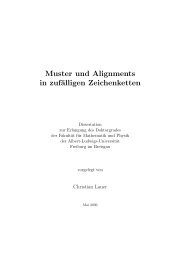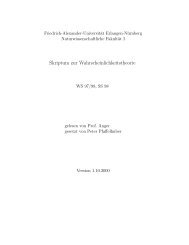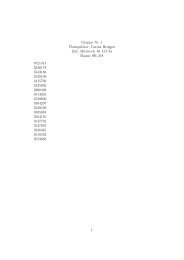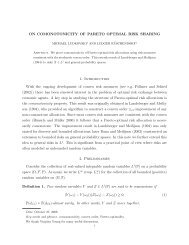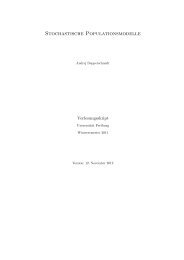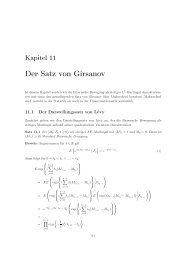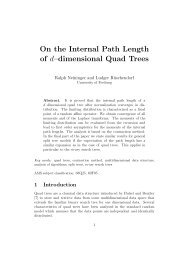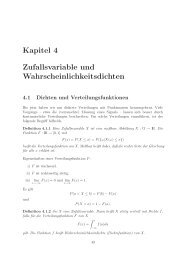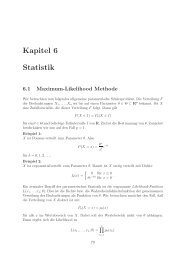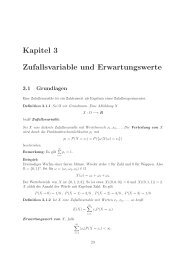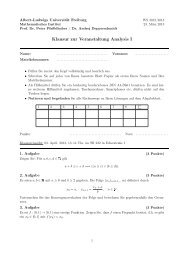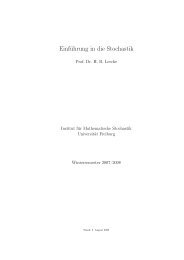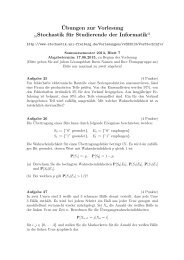Analysis of Markov chain algorithms on spanning trees, rooted ...
Analysis of Markov chain algorithms on spanning trees, rooted ...
Analysis of Markov chain algorithms on spanning trees, rooted ...
Create successful ePaper yourself
Turn your PDF publications into a flip-book with our unique Google optimized e-Paper software.
10 <str<strong>on</strong>g>Markov</str<strong>on</strong>g> <str<strong>on</strong>g>chain</str<strong>on</strong>g> algorithm <strong>on</strong> <strong>spanning</strong> <strong>trees</strong> <strong>rooted</strong> forests<br />
have to make sure that the encodings ¯B i = X ⊕Y ⊕B i are also <strong>spanning</strong> <strong>trees</strong>.<br />
By definiti<strong>on</strong> is<br />
{<br />
( ¯B′<br />
¯B i = i \ {a}) ∪ {c}, i < j<br />
¯B i−1,<br />
′ i > j<br />
for all i ∈ {0, . . . , l − 1} \ {j}. It follows as before, that these are all <strong>spanning</strong><br />
<strong>trees</strong>. ¯B j = X ⊕Y ⊕B j needs a little more work. In the first case in (3.3) holds<br />
¯B j = X ⊕ ((Y v \ {c}) ∪ {a}) ⊕ ( (B ′ j−1 \ {c}) ∪ {a} )<br />
= X ⊕ Y v ⊕ B ′ j−1<br />
= ¯B ′ j−1<br />
Obviously this is a <strong>spanning</strong> tree by the hypothesis. In the sec<strong>on</strong>d case in (3.3)<br />
we have<br />
¯B j = X ⊕ ((Y v \ {c}) ∪ {a}) ⊕ ( (B ′ j−1 \ {c}) ∪ {b} )<br />
= X ⊕ Y v ⊕ B ′ j−1 ⊕ {a, b}<br />
= ( ¯B ′ j−1 \ {a}) ∪ {b}.<br />
The circle in ¯B ′ j−1 ∪ {b} must include a and that is why ¯B j also in this case is<br />
a <strong>spanning</strong> tree.<br />
The multicommodity flow F G<br />
:= {f XY<br />
| X, Y ∈ ST(G)} <strong>on</strong> M s (G) and its<br />
codings are now defined. Because the functi<strong>on</strong>s f XY<br />
: P XY<br />
→ IR + 0 are defined<br />
<strong>on</strong> disjoint sets we can look at F G<br />
as a functi<strong>on</strong> <strong>on</strong> P := ⋃ X,Y ∈ST(G) P to XY<br />
IR + 0 and we write<br />
F G<br />
(p) = f XY<br />
(p) for all p ∈ P XY<br />
and all X, Y ∈ ST(G).<br />
The inductive c<strong>on</strong>structi<strong>on</strong> <str<strong>on</strong>g>of</str<strong>on</strong>g> F G<br />
has the positive effect that a 1-flow f XY<br />
∈ F G<br />
does not differ much to another flow f X ′ Y ′ ∈ F G<br />
if the <strong>spanning</strong> <strong>trees</strong> X, X ′ and<br />
Y, Y ′ are very similar. The following lemma makes this clear.<br />
Lemma 3.1 Given X, Y ∈ ST(G) and a node w in M := (V, X ∪ Y )/(X ∩ Y )<br />
<str<strong>on</strong>g>of</str<strong>on</strong>g> degree 3. The three edges in M at w are a, b ∈ Y and c ∈ X. Then X a :=<br />
(X \{c})∪{a} and X b := (X \{c})∪{b} are also <strong>spanning</strong> <strong>trees</strong>. Furthermore,<br />
let p a = (A i ) 0≤i≤l ∈ P X a Y<br />
and p b = (B i ) 0≤i≤l ∈ P<br />
X b Y<br />
be the paths with<br />
A i =<br />
B i ,<br />
{<br />
Bi ⊕ {a, b}, 0 ≤ i ≤ j<br />
j < i ≤ l<br />
(3.4)<br />
where j is that step in p a which exchanges b, i.e. b ∈ A j ⊕A j+1 . Then for these<br />
paths p a , p b and the multicommodity flow F G<br />
holds<br />
F G<br />
(p a ) = F G<br />
(p b ).



